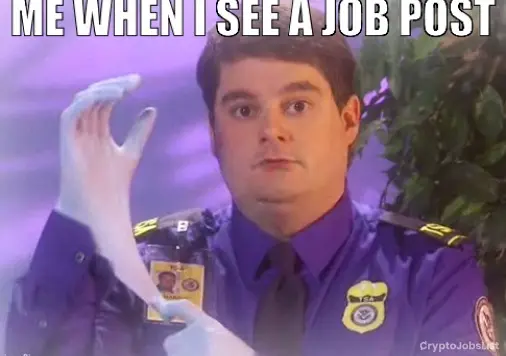A resume is often the first step while looking for a new job. It shows everything a future employee has to know, including the skills you have, the training & experience, education, expertise, and your past accomplishments.
However, demonstrating your expertise and knowledge is not easy. But the best part about Web3 is that there are ways to prove your experience, and understanding of this space.
Your on-chain activity can become your best resume.

What is an On-Chain resume?
Traditionally, a résumé (or resume) is a formal document (or Curriculum Vitae) used by the job application to give an overview of their past experience & expertise to the employer in order to ensure the job requirements are met and the person who applied is a right fit for the job.
However, an on-chain resume is nothing but your wallet.
Since your wallet and all the transactions are clearly recorded on the blockchain, it can be used to provably verify your previous activities. This verifiable activity is often more valuable as a resume than a piece of paper that talks about your education.
And since the On-Chain Resume is blockchain-based, there’s no way it can be altered or modified. Therefore, it saves a lot of time for employers as background checks can be skipped.
Why do you need an on-chain resume?
So, you want to be a part of a crypto community. You want to help the people out there with your expertise. But how do they trust your skills?

This is where an on-chain resume comes in.
An On-Chain resume is live proof of a person’s expertise in crypto. One could simply take their web3 address and put it on Etherscan to check the complete history of transactions or look it up on Opensea to check out their NFT assets. The possibilities are limitless.
The crypto space is evolving fast, with new technologies coming in every day. Companies often have a hard time hiring skilled people who are also familiar in this space. So here's how an on-chain resume can help you:
Showcasing your understanding of this space in various categories such as NFTs, DeFi, Smart Contracts, etc.
Proof of participating in various events through POAPs.
Experience of working for DAOs.
How to create an on-chain resume?
Now that you have a clear understanding of what an On-Chain resume means and how it works, let’s see how you can create your own On-Chain resume.
An on-chain resume is nothing but learning and interacting with various products on the blockchain with your wallet. So this is not a complete list. Rather, this is a list of things you can do to get started.
Register an ENS
An ENS (Ethereum Name Service) is the first logical step to do when you’re building out your wallet. An ENS gives your Ethereum wallet a unique name, making it easier for you to brand it as yours. It is basically your web3 username as well as your portfolio at the same time.
Collect POAPs by participating in events
POAPs are given out as free NFTs for participating in various events. They’re a provable record to show your participation in events.
Crypto Jobs List also gives out POAPs to our participants on our Twitter Spaces. They serve as a great proof of participation to show yourself as an early adopter.
However, be mindful of not running behind POAPs, and try to genuinely participate in these events.
Mint and collect NFTs
NFTs are not new. However, they’ve certainly caught on in the last couple of years. Having the right NFT can make it easier for networking and open up the right doors when you need it.
Even if you do not want to actively participate in NFTs, it is a good idea to get your hands dirty by learning to mint an NFT, and buy/sell them.
Trade on decentralized exchanges
Trading on a decentralized step is very simple these days. But it is the first step before other processes such as providing liquidity and yield farming.
Trade on decentralized exchanges such as Uniswap, Pancakeswap, and SushiSwap. Also, try out decentralized exchanges on other chains.
Provide liquidity for decentralized exchanges
Once you’ve learnt to trade on a decentralized exchange, the next step is to provide liquidity. Decentralized exchanges need liquidity from their users in order to function.
Go ahead and provide some liquidity on a decentralized exchange of your choice.
Participate in yield farming
When you provide liquidity on decentralized exchanges, you get LP Tokens. Stake these tokens to yield farm and receive higher returns for providing liquidity.
Lend and Borrow
You can lend and borrow on decentralized protocols such as Aave and Compound. If you have a token in your wallet that you’re going to hold, you might as well lend them out on Aave and earn interest.
Similarly, you can use the same token as collateral to borrow another token, while making sure you do not get liquidated. Trying to borrow and lend on-chain will give you a lot of valuable experience in various decentralized functions.
Bridge assets to L2 networks
L2 networks such as Polygon and Arbitrum have gained immense popularity due to their low fees and ultra-fast transaction settlements. Bridge some of your assets to one of these Layer2 chains, and try using them on various decentralized applications like trading or buying NFTs.
Execute flash loans
A flash loan is a concept that has existed on the blockchain for a very long time. You can borrow large amounts of money without any collateral, with the only catch being that the money has to be returned in the same block.
There’s a variety of reasons to try it out, and it is up to you to experiment with them. You can use furucombo to try out flash loans.
Calculate Degen score
You can connect your wallet to Degenscore to calculate how much you’ve interacted with various DeFi Applications. It is a good metric to understand where you stand and keep pushing yourself to explore new products in this space.
Conclusion: On-Chain Resume brings you closer to Web3

An on-chain resume is nothing but you exploring this space. Ever since the inception of blockchain technology, things have evolved at a rapid pace. It has reached critical mass and everyone is rushing to familiarize themselves with the web 3.0 ecosystem.
Web 3.0 is the next big thing on the internet and this is the best time to start building your portfolio and become an early adopter. With different networks and tons of opportunities, it’s never too late to build your own on-chain resume.
Crypto is one of the few places where early participants have been well-rewarded. It was either for getting in early before any price action, or through airdrops.
This process of creating an on-chain activity resume will expose you to various web3 technologies and will give you a deep understanding and appreciation of this space.








